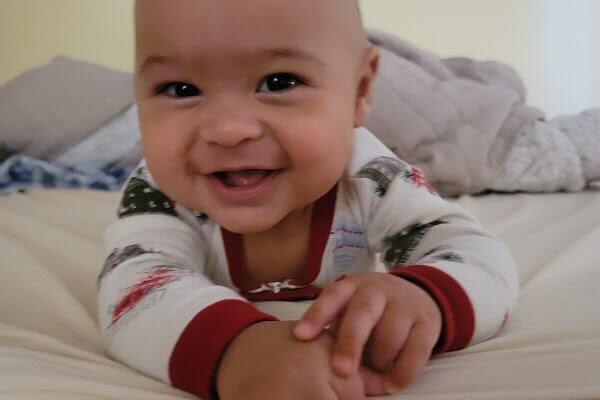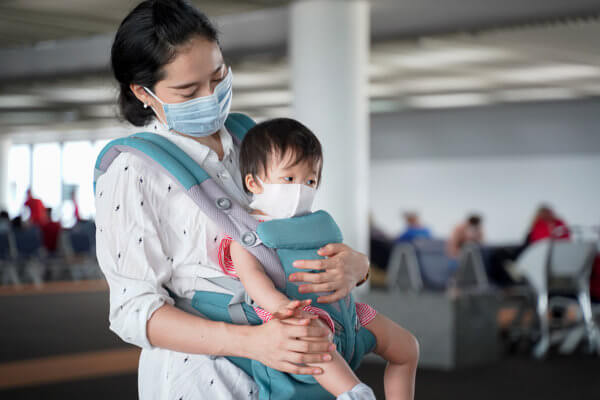Most parents know that sinking feeling and the nagging doubt that comes creeping along with it: Your baby seems like, well, maybe he’s sick. Or your toddler bumped her head, has a weird rash or is running a fever. It used to be that pediatricians were bombarded with calls from parents unable to distinguish between a minor symptom in their child and a more serious one. But now an increasing number of those calls may be getting diverted as parents turn to the Internet. An October 2011 study at the University of Louisville in Kentucky found that one in eight parents goes online for medical information before taking a child to the emergency room.
“It’s great that parents are empowering themselves and trying to problem-solve on their own,” says Mark Zonfrillo, MD, a pediatric emergency medicine doctor at The Children’s Hospital of Philadelphia, “but I caution against trusting all sources.” Zonfrillo says parents sometimes get confused or unnecessarily alarmed by inaccurate health information found online. “Always validate anything you learn online with your primary care provider,” he recommends.
To help, we’ve done some vetting for you: Based on advice from top pediatricians about common childhood symptoms, the following guide will tell you how to identify a minor condition, one that merits a call to a professional and one that warrants hightailing it to the nearest ER.
FEVER
There’s something about a fever that freaks out even the most experienced parents. But an increase in temperature is a valuable indicator. “Fever is the body’s way of responding to an infection. It may even help your child get rid of the infection faster,” says Janice E. Sullivan, MD, a critical care physician at the University of Louisville in Kentucky. Most fevers are mild and may not require professional attention; their seriousness depends on the age of the child and accompanying symptoms. However, even a mild fever (100.4 degrees F or greater) in a newborn to 4-month-old warrants an immediate call to your pediatrician or a trip to the ER. It could indicate a serious infection that needs to be treated promptly.
What to Do:
Start by getting an accurate reading. In infants and young children, the best way to do this is to take their temperature rectally. For a mild fever without additional symptoms in kids older than 3 months, you may not need to do anything. “If your child seems cranky or uncomfortable, though, you can give a pain reliever such as acetaminophen,” says Sullivan, “but always make sure you follow the dosing directions on the box, use the measuring instrument that comes with the product and don’t combine several products that contain pain relievers.” If you’re ever confused about the correct dose, call your pediatrician. It’s far from a silly question; the American Association of Poison Control Centers says accidental overdose of analgesics (including acetaminophen) for children up to age 5 is one of their top calls. And, in fact, acetaminophen poisoning can lead to liver damage or failure.
Take cues from your feverish child’s behavior and any other symptoms, Zonfrillo urges. If your tot has a fever and isn’t eating, drinking or playing—or if, in addition to the higher-than-normal temperature, she’s vomiting, has diarrhea or a rash, is pulling at her ears, or is very sleepy or hard to wake up—call your pediatrician. Your little one could have a bacterial infection that requires antibiotics, or may need to be checked for dehydration. “It’s important to be observant as a parent. It will help your pediatrician diagnose and treat your child if you can offer a complete health history—all of the symptoms, how long they’ve lasted and any over-the-counter medication you’ve given her,” says Sullivan.
If your child’s fever persists for more than a few days, does not come down with anti-fever medication or prompts a febrile seizure, call your doctor or take your little one to the ER to get checked out.
Coughs & sniffles
This may come as a surprise to parents who grew up downing spoonfuls of cough syrup, but doctors now rarely recommend over-the-counter cough and cold remedies. “Cold products haven’t been shown to be helpful,” says Sullivan. “And you can overdose your child very easily.”
What to do:
Sullivan recommends saline nose drops, staying hydrated and even using a cool-mist humidifier in the child’s room to make him more comfortable. If a cough and sniffles are accompanied by other symptoms—for example, not eating or drinking, lethargy or chills—call your doctor. Your child may need to be treated for a bacterial infection. Also, if a cough persists, is uncontrollable or sounds like a barking seal, call the doctor. Your little one could have bronchitis or pertussis (whooping cough). Shortness of breath constitutes a true emergency. If your tot seems to be breathing abnormally, call your pediatrician immediately and/or take your child to the nearest emergency room.
Rashes
Young children are vulnerable to skin rashes. Most are harmless, but some require treatment if accompanied by a fever.
What to do:
Call your doctor for an appointment. Rashes can be associated with a wide range of conditions—from the measles or strep throat to poison ivy. “You always want to keep the skin cool and comfortable,” says Sullivan. “But don’t treat a rash with special creams or lotions until you have it checked out by a physician.” Hand, foot and mouth disease, for example, is a common virus in children under age 5; while it may alarm parents, there’s no treatment but time. Eczema, a red, itchy skin condition, may benefit from over-the-counter or prescription treatment. At its worst, eczema could create a secondary infection and require an antibiotic. Let your doctor decide.
Slips & Falls
Taking a tumble can be a routine occurrence for tots who are still mastering motor skills. “If you see them fall and they gently hit their head on something soft, that’s not a big deal,” says Zonfrillo. If the baby acts normal, he’s probably okay. Falls are serious if the child hits something hard, gets knocked out, vomits, has a seizure or behaves strangely afterward.
What to do:
For very minor bumps, apply an ice pack to reduce any swelling (if your child will allow it; often they merely shake off these spills and move on to play more). Small scrapes can be handled with an over-the-counter antibiotic cream and a bandage. For serious falls, call your doctor and/or get to the ER, says Zonfrillo. Don’t be surprised, however, if you bring your child to the ER and little beyond observation is done. “There’s a movement to do fewer CT scans and X-rays to avoid unnecessary radiation,” says Zonfrillo. “Even if little testing is done, the visit is still useful.” ER docs will rule out conditions such as concussion, skull fracture or bleeding in the brain.
Mouth Injuries
“When kids are learning to walk, even learning to crawl, mouth injuries are quite common,” says Rhea Haugseth, DMD, a pediatric dentist in Marietta, Ga., and president of the American Academy of Pediatric Dentistry. “The great majority of the injuries are to the upper teeth, lips and gum—the areas that tend to hit first when kids fall forward.”
What to do:
Your dentist or pediatric dentist should have a 24-hour emergency number. Haugseth advises calling right away. Note: If the mouth injury is on the outside of the face, you may be referred to ER for stitches in that area first. However, your dentist will handle inner mouth and tooth issues.
Injuries can range from tiny or significant tears in the frenulum (the tissue inside the mouth that attaches the lip to the gum) to tooth and gum damage. For suspected frenulum tears: Apply direct pressure on the outside of the lip to stop bleeding, then pull up the lip and check the injury. Sometimes you can hardly see the tear. Other times it’s large and needs sutures. “It’s rare that this needs sutures, but when it does, they’re absolutely needed,” says Haugseth. Even if the tear doesn’t require stitches, there’s aftercare: Using a Q-tip or gauze dipped in a solution of half water and half peroxide, swab the injury at least a couple of times a day for a week or so. Also keep brushing teeth daily. To reduce pain and swelling immediately, you can also apply ice or allow your child to have a popsicle.
When a tooth is pushed up, knocked out or chipped—even a baby tooth—see your dentist promptly. “Sometimes parents just leave these injuries to heal on their own, but if [the child is treated] right away, often the healing will be a lot better,” says Haugseth. Without treatment, there could be a permanent defect around the tooth, which could impact tooth health or the appearance or color of teeth and gums later.
Ingesting Hazardous Items
Sullivan says that she sees a child in the ER almost daily because he or she got into medication that a parent left sitting around. “Medications are supposed to come with safety caps, but don’t trust those. Kids can sometimes manipulate them and open them,” she warns. The caps on cleaning products are also easy for some kids to open.
What to do:
Immediately call the poison control hotline at (800) 222-1222. “This number should be posted somewhere near your phone,” says Sullivan. If you can tell poison control what your child ate (or what you suspect), how much and what your child weighs, they will tell you the next step.
When in Doubt, Call Your Doctor
The bottom line with any childhood ailment or injury is that parental instinct trumps all. “If you feel something just isn’t right with your child,” Zonfrillo says, “call your doctor, go to the ER or call 911.” Doctors don’t dismiss parental intuition. “If a parent tells me, ‘I don’t know what it is, but something isn’t right,’ that’s extremely powerful,” he says. “I always listen to and respect that.”
Victoria Clayton is a freelance writer in Southern California and the coauthor of Fearless Pregnancy: Wisdom and Reassurance from a Doctor, a Midwife and a Mom (Fair Winds Press, 2004).



